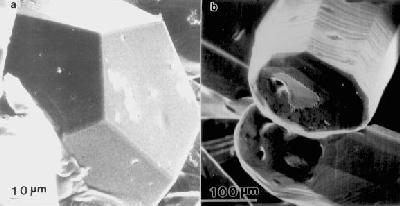|
||||
|
|
||||
Quasicrystals - Introductionby Ron LifshitzWhat are quasicrystals? Why was their discovery by Dan Shechtman in April of 1982 met by so much disbelief that it took it more than two and a half years to find its way into the scientific literature? Why was there so much fuss about having 5-fold symmetry in the first place? What do we actually mean when we say that a crystal has such a symmetry? Before we answer these questions let us first review some of
the background. For centuries crystals were merely thought of as solids
which have flat surfaces (facets) that intersect at characteristic angles.
This is what we often see at mineral exhibitions in
museums of natural history. It is also what we see
when we look at certain quasicrystals like the ones shown in the figure
below.
|
||||
 Figure
1. Scanning electron micrographs of single grains of quasicrystals:
(a) an Aluminum - Copper - Iron alloy which crystallizes in the shape of
a dodecahedron. This is one of the five Platonic
solids, containing 12 faces of regular pentagons. Its symmetry is the
same as that of the icosahedron, one of the other platonic solid with 20
faces of equilateral triangles. (b) An Aluminum - Nickel - Cobalt alloy
which crystallizes in the shape of a decagonal (10-sided) prism.
Photographs courtesy of An
Pang Tsai, NRIM, Tsukuba, Japan. Figure
1. Scanning electron micrographs of single grains of quasicrystals:
(a) an Aluminum - Copper - Iron alloy which crystallizes in the shape of
a dodecahedron. This is one of the five Platonic
solids, containing 12 faces of regular pentagons. Its symmetry is the
same as that of the icosahedron, one of the other platonic solid with 20
faces of equilateral triangles. (b) An Aluminum - Nickel - Cobalt alloy
which crystallizes in the shape of a decagonal (10-sided) prism.
Photographs courtesy of An
Pang Tsai, NRIM, Tsukuba, Japan. |
||||
|
||||
|
The idea that crystals are periodically ordered was amazingly successful. Crystallographers were able to predict all the characteristic angles that could appear between the facets of crystals of any given type. With the discovery of x-ray diffraction in crystals by Max von Laue in 1912 and the subsequent development of x-ray crystallography by William H. and William L. Bragg the theory of crystallography received an unequivocal stamp of approval. During the seventy (!!) years that followed, all observed diffraction diagrams were in complete agreement with the predictions of this theory and with the notion that all crystals achieve their order through periodicity. It is no surprise then that periodicity, though never proven to be a requirement for order, was incorporated into the definition of crystal. Thus, on the eve of the discovery of quasicrystals, everybody "knew" that crystals were solids composed of a periodic arrangement of identical unit cells. |
||||
|
||||
|
The crystal that Shechtman discovered, as well as scores of other crystals that have been discovered since 1982, have been named "quasicrystals," which is short for "quasiperiodic crystals," by Levine and Steinhardt in 1984, in a first of a series of papers from the University of Pennsylvania that set up much of the initial theoretical foundations of the field . Quasicrystals share many of the characteristics of their periodic siblings: they can exhibit facets (Figure 1); they produce diffraction diagrams with sharp peaks (Figure 3, see more detail below); and those which are thermodynamically stable, like the AlPdMn quasicrystal in Figure 4, can be grown to very large dimensions and have a degree of microscopic order which surpasses even that of the most perfect periodic crystals. Quasicrystals are also very different from periodic crystals. They may possess rotational symmetry which is incompatible with periodicity. To this date, quasicrystals have been found that have the symmetry of a tetrahedron, a cube, an icosahedron [Figure 1(a)], and that of 5-sided, 8-sided, 10-sided [Figure 1(b)], and 12-sided prisms. They also possess unique physical properties that are currently under vigorous study, most notably the fact that even though they are all alloys of two or three metals they are very poor conductors of electricity and of heat. |
||||
|
||||
On diffraction and the new definition of "crystal"Before we end this introduction we should say a few words about diffraction experiments and the current definition of "crystal." A diffraction experiment directly probes the degree of order in a solid by measuring density correlations, namely, what are the chances of finding an atom at a certain location if we know that there is another atom at some other given location. [In more technical terms: The diffraction experiment displays the Fourier transform of the two-point density correlation function of the solid, also known as the "Patterson function."] If there is order the diffraction diagram shows a set of spots, called "Bragg peaks," in an otherwise essentially dark background. The longer the range of the correlations in the solid the sharper these peaks are.In 1991, the International Union of Crystallography decided to redefine the term "crystal" to mean any solid having an essentially discrete diffraction diagram. Within the family of crystals we distinguishes between "periodic crystals," which are periodic on the atomic scale, and "aperiodic crystals" which are not. This broader definition reflects our current understanding that microscopic periodicity is not necessary for achieving order, yet it is sufficiently vague to reflect our uncertainty as to what are the necessary requirements for order. The new definition is based on the outcome of an experiment rather than a set of microscopic rules. One can also use the diffraction diagram to distinguish between periodic crystals and quasicrystals as follows: Each Bragg peak in the discrete diffraction diagram defines a vector which points from the center of the diagram to that peak. In a diffraction diagram of a periodic crystal (in three dimensions) one can always find three peaks, corresponding to three vectors b1, b2, and b3, which can be used to index all the other peaks. This means that any other peak can be generated as a vector sum with three integer coefficients (h,k,l) as hb1+ kb2+ lb3. In the case of a quasicrystal one needs more than three wave vectors to generate all the peaks and therefore more than three integers to index each peak. |
||||
|
This is it for the introduction. We still need to explain the notion of symmetry for quasiperiodic crystals. In order to do that we shall take a careful look at the effect of rotations on quasiperiodic tilings, like the famous Penrose tilings, which are used as models of quasicrystals. |
||||
|
|
||||
Upcoming Conference in Israel
October 14-19, 2007, Tel Aviv, Israel. |
||||
|
|
||||
|
||||
|
|
||||
|
||||
|
|
||||
|
||||
|
|
![]()
Slightly modified: January
2, 2007 by Ron Lifshitz.
This page has been visited
times since February 20, 1999.